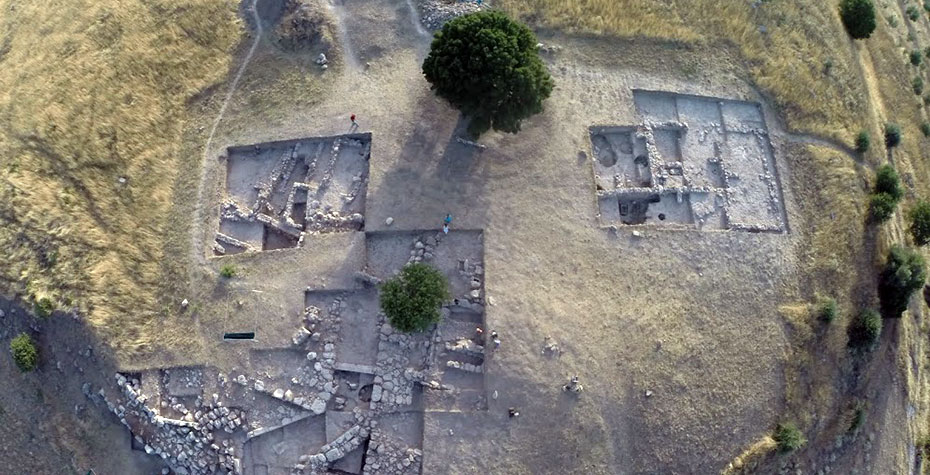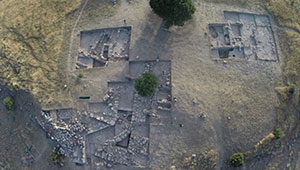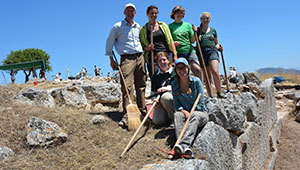Bryan Burns and Five (Green Class) Wellesley Women Unearth History This Summer

Associate Professor of Classical Studies Bryan Burns is a co-director of the Eastern Boeotia Archaeological Project, an organization leading fieldwork in an area of central Greece known as Eleon, not far from Athens. This small region is believed to be one of the earliest inhabited regions in ancient times. Burns has been part of this project for several years, and returned for more excavation work this summer.
Joining Burns in Eleon were (left to right in photo) Morgan Condell ’09, Ph.D. student at UPenn; Haley Bertram ’13, M.A. student at University of British Columbia; Sophie Rowland ’17; Tessa Kellner ’17; and Chandra Boudreau ’17—all, incidentally, women from green classes, as you might guess by the hue of the t-shirts in the photo. (You may also note the alums wearing their “Wellesley pearls.” Humor is a key element at the dig.)
The participation of the three current students was funded by Classical Studies Department awards for student academic travel, made possible by gifts from Edith Tufts and Anna Marguerite McCann Taggart. Kellner will continue to work on excavation records and analysis next academic year through a work-study position that is part of the Sophomore Early Research Program. These rising sophomores got a jump on their Wellesley network connections, and the young alums got a chance to serve as colleague-mentors. Bertram was making her fourth trip to Greece. This was Condell's third season at the site.
She recalls, "I joined Bryan's project three years ago now after my first year in graduate school. I started out as a volunteer excavator, not unlike the Wellesley students who joined us this year. That was my first time on an excavation, and I learned to dig working in the trenches just as they did. Haley was in her second year on the project at that time; we worked in the same trench for several weeks, and I learned a lot from her that first year, too!" This year, Condell and Bertram served as trench supervisors. Kellner and Rowland both worked in Condell's trenches this season, and Boudreau spent many hours photographing the pottery excavated in that area.
With the project beginning in late May, Condell was unable to attend her five-year reunion. She was sad to miss it, she says, but working with the other Wellesley women brought a similar kind of reconnection: "It was great to be reminded that Wellesley is something I can always tap back into, since all of us have the kind of common experiences that effortlessly create community, even on a different continent amongst students and alums separated by many years."
The Wellesley group is part of an international team of 50 scholars and students (mainly from Greece, Canada, and the United States) that participated in six weeks of excavation at ancient Eleon. Burns co-directs this project with the Greek authority for that region, Alexandra Charami, and Brendan Burke, associate professor and chair of Greek and Roman Studies at the University of Victoria, who runs a field school through that institution. (See the project blog EBAP Eleon Excavation.)
"Working with Bryan and his co-director Dr. Brendan Burke on this project has been a fantastic experience for me," says Condell, "and one more way that Wellesley has made a major contribution to my development as a scholar of the ancient Greek world. Though Bryan wasn't one of my professors at Wellesley (he joined the faculty during my senior year, and I was occupied with other courses during those last semesters), he has now joined the ranks of the professors there—Ray Starr, Kate Gilhuly, Guy Rogers, and the late Miranda Marvin, especially—who set me on my current path."
 As for the work on the ground, Burns reports that at this site they are uncovering aspects of the settlement active during three main phases: the Mycenaean culture of the Late Bronze Age 1600-1100 BCE; Archaic-Classical periods 600-400 BCE; and the Ottoman period 1400-1600 CE. Most of the structures in the aerial photo are from the Mycenaean and Classical phases. The big stone wall seen in the photo below was built in the late Archaic period (ca. 500 BCE).
As for the work on the ground, Burns reports that at this site they are uncovering aspects of the settlement active during three main phases: the Mycenaean culture of the Late Bronze Age 1600-1100 BCE; Archaic-Classical periods 600-400 BCE; and the Ottoman period 1400-1600 CE. Most of the structures in the aerial photo are from the Mycenaean and Classical phases. The big stone wall seen in the photo below was built in the late Archaic period (ca. 500 BCE).
 Burns says, “One of the most interesting aspects of the site is its long, episodic history. The ruins of the Mycenaean settlement probably inspired the later identification of Eleon as a place of heroic times: According to the Iliad the city sent troops to fight at Troy. When the big wall was built in the late Archaic period, the builders made use of Bronze Age remains in the new construction. So we like to think that we are just the newest group of people interested in these stone walls!”
Burns says, “One of the most interesting aspects of the site is its long, episodic history. The ruins of the Mycenaean settlement probably inspired the later identification of Eleon as a place of heroic times: According to the Iliad the city sent troops to fight at Troy. When the big wall was built in the late Archaic period, the builders made use of Bronze Age remains in the new construction. So we like to think that we are just the newest group of people interested in these stone walls!”
Aerial photography is new to the site study this year, made possible with equipment purchased through the Sandra Polk Guthman '65 Instructional Technology Fund. (The camera will be used for other instructional and research projects when the drone returns from Greece this summer.) Burns reports, “The quadcopter drone is challenging to fly in our dig environs—with wind, and no soft landing area—but we’re thrilled to have these new photos that show the extent of our excavations.”
